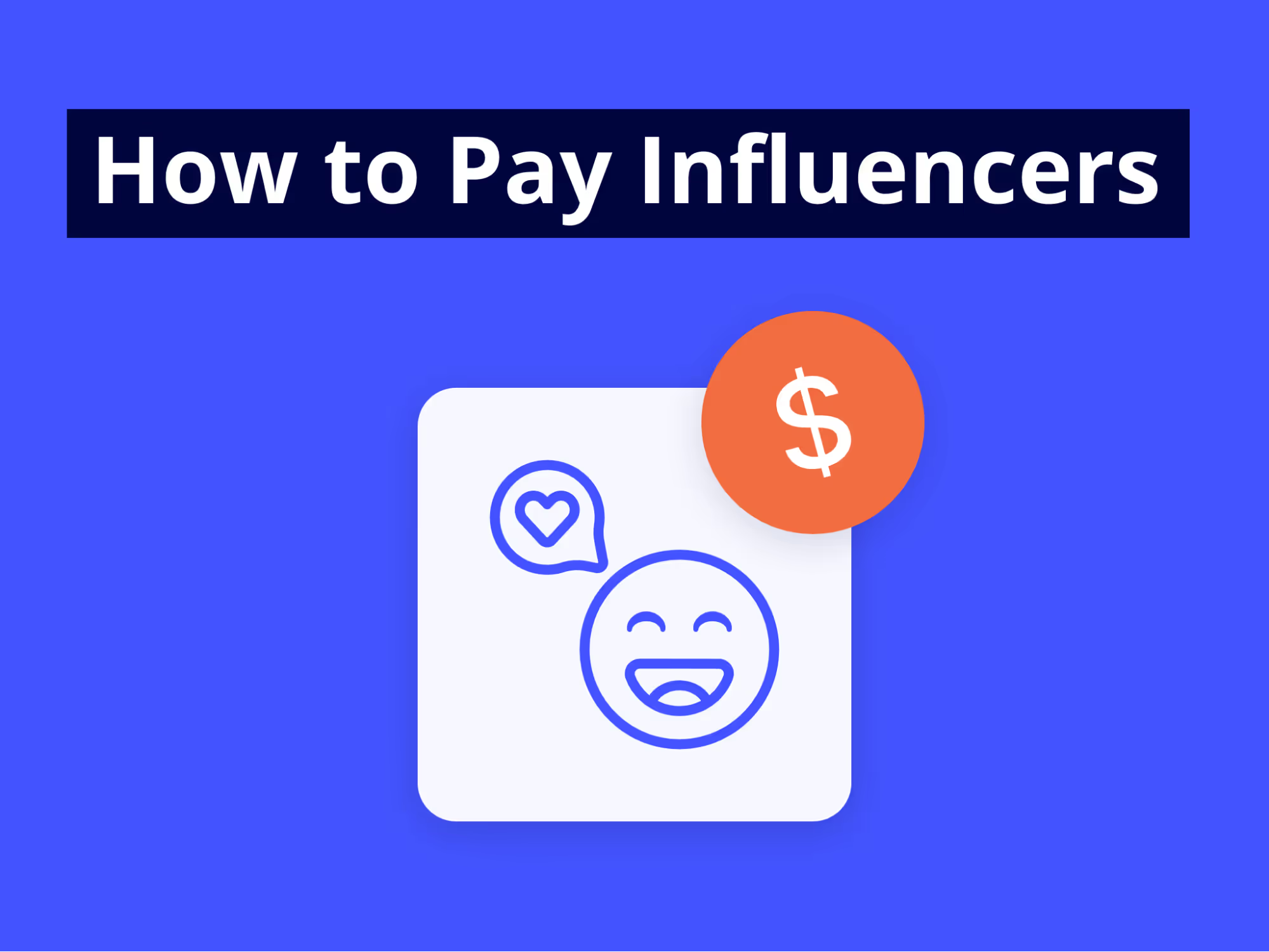If I could answer the question “How to pay influencers?” in one sentence, I’d paraphrase veteran marketer Nycole Hampton and say: “Pay fairly and spend efficiently.”
But negotiating a cost-effective and mutually beneficial partnership with an influencer is uncharted territory for many marketers. To give you an overview, you have the following options for compensating an influencer:
- Performance-based pay: An influencer publicly recommends your product, and you only pay when their content converts a customer or triggers a successful event like a purchase, booking, download, newsletter signup, etc.
- Pay-per-post: As the name suggests, you pay an influencer for a post (or set of posts).
- Fixed-rate and performance-based pay: You pay the influencer a base sum for each post (or some other set fee, e.g., activation or per campaign), and they must generate sales to get additional pay.
- Gifting and credits: You gift your product to the influencer as “payment,” or the gift acts as an initial introduction to the brand.
- Comped events or travel: Similar to gifting, you invite influencers to events as “payment,” or you pay for them to travel.
Knowing these options is one thing, but how do you choose the right one? And how much should you pay (or gift)?
There is no one-size-fits-all solution when it comes to contracts, compensation, and paying out influencers.
The upside: these payment models are so versatile, they can be used separately or in combination, in any way that suits your specific brand and budget.
The downside: there are no hard and fast rules to follow to guarantee success.
But, once you understand the way each payment works, you’ll feel much more confident in choosing a method that compensates influencers fairly and helps you spend efficiently.
To learn more about how much to pay influencers, see how 42 influencer marketers like you figure it out, and below are some issues they had to overcome first.
Payment problems influencer marketers are facing
No standard pricing models, and costs vary wildly = What do I do? 🤯
The reality is that influencer costs vary wildly. An influencer just starting out might accept free gifts while the biggest creators are working on multi-million-dollar deals.
Costs even vary with the same influencer. Someone might work with a large brand for free today because they believe it has value, then ask for hundreds of dollars tomorrow for a post from a smaller brand.
Most influencer marketers attempt to gain clarity up front by simply asking influencers for their rates:

But once you know their rates, you might still have to negotiate. And since there’s no standard pricing, there’s plenty of room for mistakes and confusion.
At this point, most articles will (metaphorically) shrug and tell you to figure it out for yourself 🤷 But you’re in luck because this isn’t most articles!
I’ve spoken to a bunch of influencer marketing experts to better understand expected pricing levels across the main marketing platforms. Here’s what they told me for Instagram, TikTok, and YouTube…
Instagram influencer pricing benchmarks
On Instagram, most influencer content falls into one of two categories:
👉 Stories: Authentic, unpolished “ephemeral” content – also known as disappearing content – with clickable links.
👉 Reels: Snappy videos with built-in virality.
Interestingly, influencer marketers see more value in Reels than in Stories (or in-feed posts)...
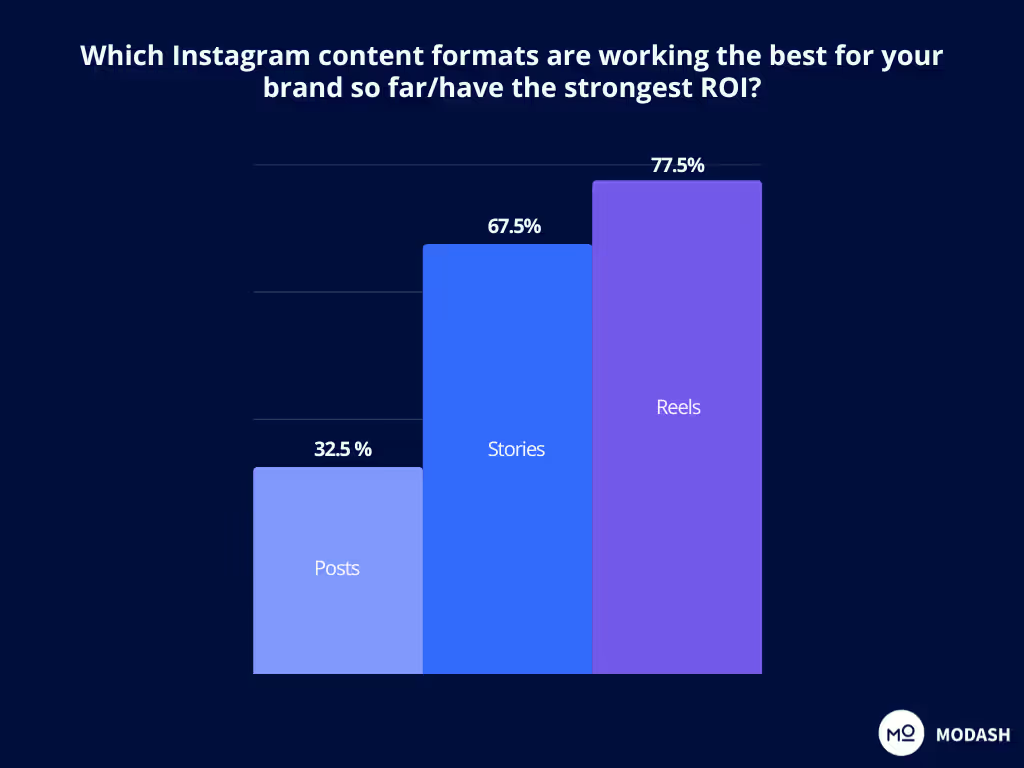
…although they also noted that Stories:
✅ Require less effort to create
✅ Incorporate link clicks
✅ Are a more direct/trackable way to drive traffic
Let’s take a look at pricing benchmarks for these two content formats, largely based on US pricing in the home and lifestyle category:
Bear in mind that prices may skew higher in niches like beauty, fashion, and finance, and that influencers outside the US might charge significantly less. Prices can also be bumped up by factors like…
👉 Usage rights
👉 Exclusivity
👉 Number of frames in a Story
…while bundling Reels and Stories together can result in discounts of 10% – 30%.
🤓 Further reading: Instagram Influencer Pricing: What To Buy, Costs, & How To Negotiate
TikTok influencer pricing benchmarks
TikTok supports the same content formats as Instagram, with the addition of TikTok Shop.
That’s right – live-streamed content, stories, and static posts all exist on TikTok. Who knew?
However, the influencer marketers I spoke to agreed that videos are still the top priority on TikTok. With that in mind, let’s check out benchmark prices for TikTok videos based on influencers in North America:
The same disclaimers apply here – influencer pricing varies by location, niche, and pretty much anything else you can imagine. But these benchmarks should at least give you a jumping-off point.
🤓 Further reading: The Influencer Marketer’s Guide to TikTok Pricing
YouTube influencer pricing benchmarks
Things are a little more complicated on YouTube due to the sheer variety of influencer content deliverables:
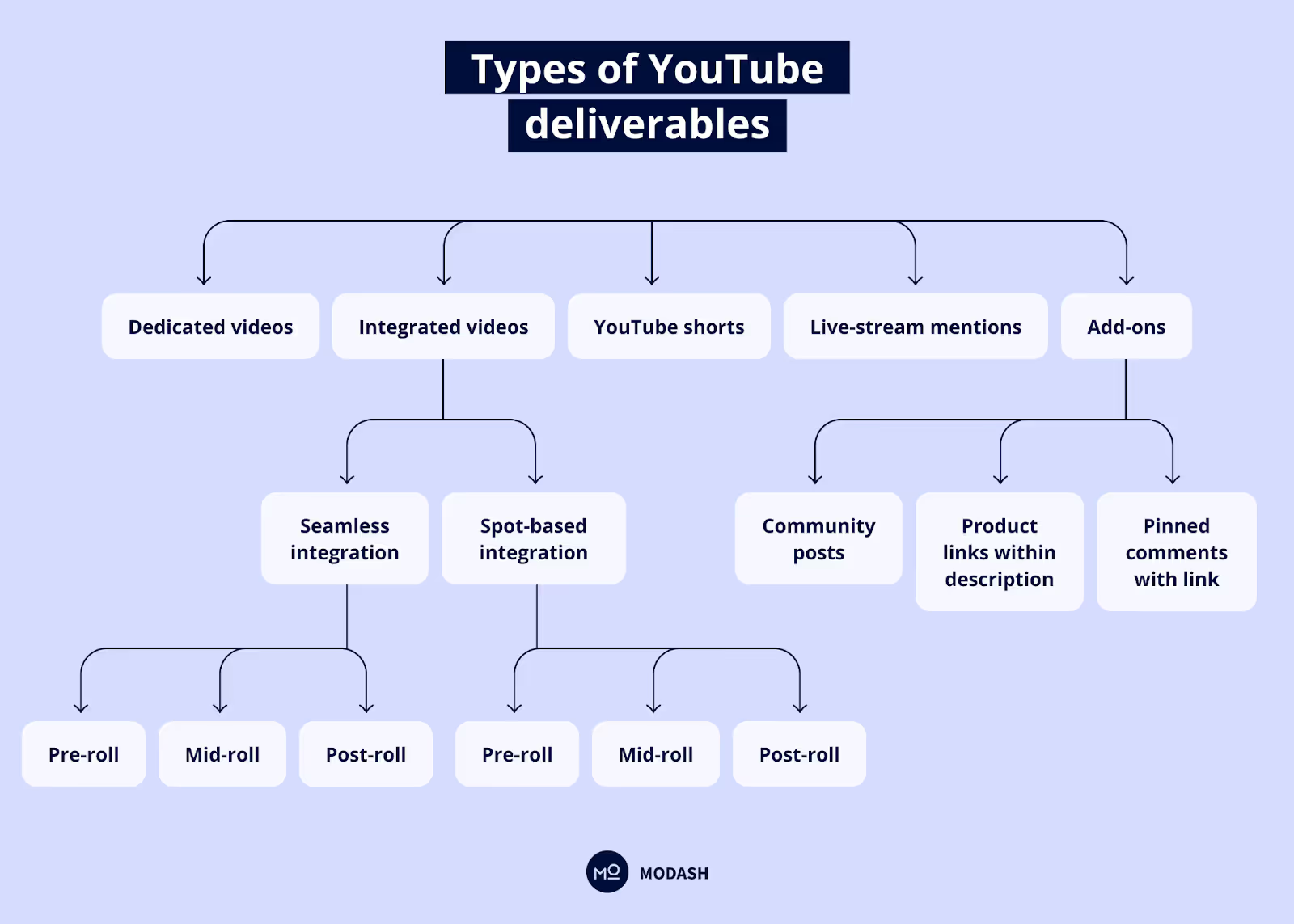
So there’s no way to express a universal benchmark price for YouTube videos. You’ve got to decide the most appropriate video format among…
👉 Dedicated videos
👉 Integrated videos
👉 YouTube Shorts
👉 Live-stream mentions
… then factor in various other considerations, like whether it’s a seamless or spot-based integration, and whether your brand mention will appear pre-, mid-, or post-roll.
It’s enough to make your head hurt.
As well as location and content format, YouTube pricing is affected by videos and subscriber counts, plus additional factors like the influencer’s niche, their social status, and your project deadline.
🤓 Further reading: YouTube Influencer Pricing: What To Buy, Costs, & How To Negotiate
Marketers aren’t confident negotiating = How and what do I negotiate? 🤯
As you can see, there are a lot of unknowns and moving parts when it comes to paying influencers, all of which makes negotiating terms with influencers a daunting task.
You might be thinking:
👉 “What if my budget is too low? Will they dismiss me?”
👉 “I really want to work with this influencer, but their fee is way too high.”
👉 “What if I overpay and lose money on the partnership?”
For their part, influencers can throw marketers off by asking for unrealistic fees.
Marketers, on the other hand, may not be aware of the different payment models they can leverage or the metrics they can use to negotiate better prices.
To make things more complicated, you likely can’t afford to price solely on expected reach or the deliverables you’re asking for, with the majority of influencer marketers we surveyed accounting for both of those factors in their pricing decisions.

Fact is, whether you’re asking an influencer for an Instagram Story, a TikTok video, or a YouTube integration, promoting your brand takes time. So it’s hard to separate reach and deliverables from pricing.
The complex workflow of paying out creators = When did I become an accountant? 🤯
Once you’ve gone through the challenging negotiation process and have agreed on a price, you still have to:
👉 Capture and track the influencer’s content performance
👉 Request an invoice from them
👉 Approve the invoice
👉 Send out their money
If you’re working with influencers globally, then you have to figure tax compliance and a bunch of other legal stuff into the equation.
Bearing the above in mind, how do you bridge the gap between influencer expectations and marketing budgets? And how do you manage invoicing and payments on top of all that?
You start by choosing a payment model. Let’s first take a bird’s-eye view:
5 ways to pay influencers and how to choose the right payment model
1. Performance-based pay
This is usually the ideal compensation model for brands, as it has the lowest risk and highest scalability.
Performance-based pay is straightforward: an influencer recommends your product, and you only pay them when their content converts a customer or triggers a successful event, like a purchase, booking, download, newsletter signup, etc.
Performance-based pay is usually calculated by a percentage of sales, for example, between 5% and 30%, depending on margins.
Why brands choose performance-based pay
Brands prefer performance-based pay because it’s infinitely scalable compared to the other payment models on this list. Since you only pay when a creator makes a sale, there’s far less risk that you won’t see a positive return on your investment.
It’s also easily trackable: you can use tools that help you measure performance, like unique landing pages and promo codes. Affiliate software will automatically pay out influencers at the end of the agreed period. You can also build UTM links as a quick and free way to track influencer traffic and conversions in Google Analytics.
Plus, performance-based pay is a smart way to build long-term relationships with influencers. It encourages effort and commitment, as influencers will only earn as much as the work they put in.
When to use this payment method
Performance-based pay is a fit for virtually any brand, whether you are in the consumer goods space (beauty, fashion, some electronics, home decor) or the digital space (apps).
A factor to consider is the goal of your campaign. For example, brands usually opt for performance-based pay in direct sales campaigns. Using a performance-based model wouldn’t make sense if your campaign goal was, say, brand awareness.
Additionally, performance-based pay is most effective with smaller, more niche influencers. As follower numbers increase, depending on the commission you offer, this model becomes costlier. (In that case, consider a pay-per-post payment option – next on this list – when working with bigger creators.)
As for the commission rate you should offer, it depends on your product or service, and your margins. Generally, products or services with high margins can afford higher commissions. Conversely, low margins will impose lower commissions.
For example, a mobile app, SaaS, or digital product has higher margins than a physical product, so it’s not uncommon to offer commissions over 20% on those tools.
When we asked 35+ marketers, 60% said they offer between 10% and 14% commission, while 40% said they provide over 15% commission.

What to do if influencers push back
If you are considering the performance-based pay model, expect influencers to push back on your offer because it doesn’t guarantee them a fixed income. They’re also acutely aware of the unpredictable nature of algorithms and consumer behavior. Also know that some larger creators may not accept 100% performance-based pay.
That said, our research indicates that influencers are becoming more open to performance-based payment deals:

🤓 Further reading: Find more results from this survey in Influencer Trends: How Diversifying Your Program Will Lead to Success in 2025.
According to Miroslava Petkova, this increasing acceptance of affiliate arrangements is largely a case of supply and demand.
If you do face objections around performance-based pricing, try to sweeten the pot for your influencer. For instance, we often see brands provide free products or an “activation payment” to kick off the partnership. In some cases, paying a commission on top of a base fee is the best choice. (We’ll discuss this payment model later.)
2. Pay-per-post
Believe it or not, pay-per-post rates can be anything – we’ve paid out influencers from $100 to five-plus-figure sums.
These rates depend on a ton of factors, but most typically:
👉 The platform
👉 The niche
👉 Metrics like audience engagement and fake follower rate
👉 The campaign type and deliverables
👉 The partnership duration (e.g., one-off project vs. year-long contracts)
👉 The geographical market
The key characteristics of pay-per-post are transparency in payment and clarity on deliverables. The agreement is for a set number of posts over a defined period.
Pay-per-post doesn’t automatically mean it’ll be a one-off collaboration. Typically, brands pay influencers for a specific number of posts, usually as part of a short-term campaign or product launch.
But pay-per-post can also be structured into campaigns that take place over several months or even in long-term ambassador programs, making this payment model a viable option for the 84.4% of influencer marketers planning to build more long-term partnerships in 2025:
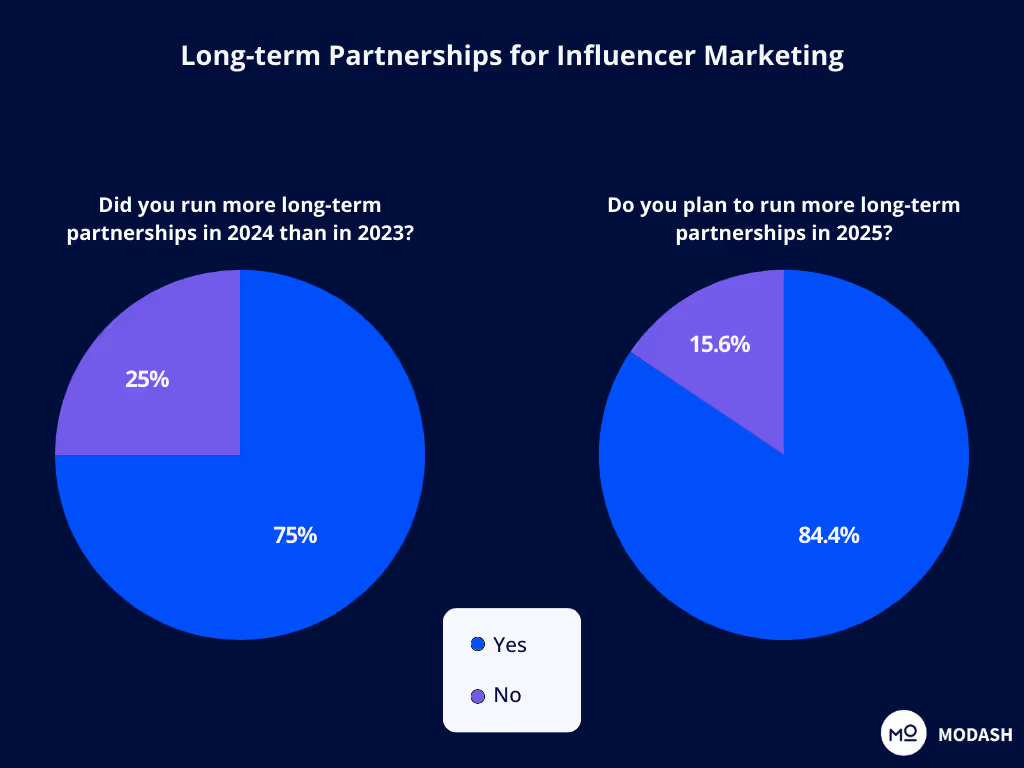
Why brands choose pay-per-post
In contrast to performance-based pay, most creators jump on a pay-per-post collaboration because it is not dependent on conversions. As long as the creator posts the agreed-upon content, they are guaranteed payment.
For brands, too, pay-per-post is appealing because it guarantees deliverables. Paying influencers per post is also a great way to build more enduring partnerships, in particular with those who have large followings.
There’s another benefit for brands: since pay-per-post is the preferred payment type among influencers, your outreach and recruitment will be more successful. Influencers are more likely to reply and say yes to a collaboration when they know they’ll get paid.
Mature influencer marketing programs in big (often luxury) brands prefer this model too because it’s simpler to run as long as you have the right tools to track each post’s performance separately.
For example, Modash’s ecommerce customers use our Campaign Monitoring tool to track performance of each post, including reach, impressions and number of likes and comments.
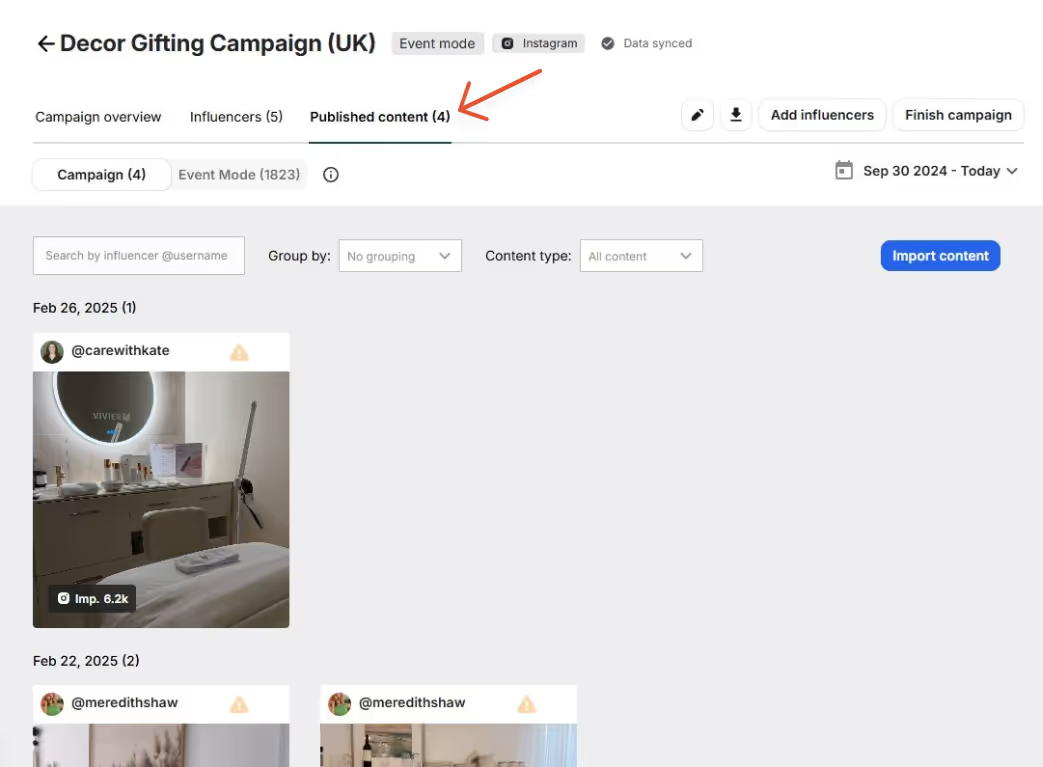
The downside of pay-per-post is that it’s hard to tie ROI to direct results, especially at scale. Marketers often solve this by adding links to unique landing pages, point-of-sale surveys, or using advanced measurements like marketing mix modeling.
Another way to get around the ROI troubles of pay-per-post is by using an influencer marketing platform to handle your payments for you – like Modash. In Modash, you can pay your influencers in a few clicks, and you have all of your payment and performance data right within the platform – without having to run to a spreadsheet.
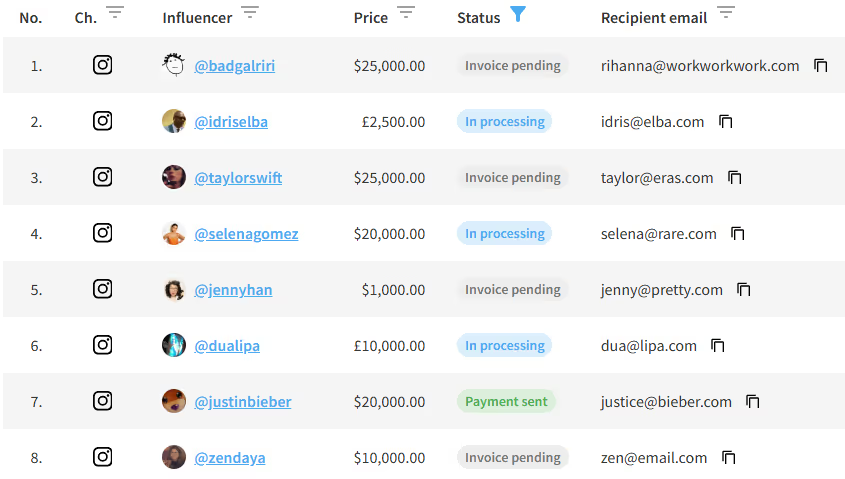
When to use this payment method
Like performance-based pay, pay-per-post is versatile and available to marketers in different industries, products, and scenarios.
We see four scenarios in which pay-per-post makes the most sense:
👉 For new influencer marketing programs: It gives you a clearer idea of campaign processes and helps with future planning.
👉 For partnering with more prominent creators: Popular creators and creators represented by talent managers aren’t generally open to commission-based deals. In these instances, marketers offer pay-per-post compensation.
👉 For brand awareness campaigns: Ideal for these campaigns as the goal is visibility, not immediate sales. Paying larger creators a fixed fee can offer lots of exposure, and partnering with them can also serve as social proof when recruiting influencers in the future.
👉 For promoting low-margin products: A fixed cost per post is more manageable and cost-effective when revenue-sharing is less viable due to low profit margins.
Remember that as trust and mutual understanding grow, the payment method can evolve to performance-based compensation, which we’ll discuss in a moment.
What to do if influencers push back
Although pay-per-post is the most attractive payment option because it’s less risky and more stable for the influencer, this doesn’t mean you won’t get any objections. Some influencers will have set rates that may be out of your budget.
In scenarios like this, it’s crucial to negotiate fair compensation based on expected performance outcomes. To do this, you’ll need data.
In a payment survey we ran in October 2023, marketers shared the top data points they rely on to make pricing decisions. These were:
👉 Engagement rate
👉 Percentage of the audience in a target location
👉 Average views
👉 Percentage of audience of a target gender/age

You can get engagement rate, audience location, and average views directly from influencers – or use a tool like Modash, and you can also get the fake follower rate.
All influencer profiles in Modash show basic and advanced data about an influencer’s performance.

Use this data in your negotiations with influencers to justify your offer. For instance, if an influencer has 120K followers but a significant portion are fake accounts or bots, it’s reasonable to adjust your offer accordingly.
Clear, data-backed communication helps set realistic expectations and paves the way for a transparent and trusting partnership.
3. Fixed-rate + performance bonus
Otherwise known as the best of both worlds.
A fixed-rate deal combined with commission (or a performance bonus) is the most mutually beneficial payment method for influencers and marketers.
Here’s how it works: an influencer is paid a base sum for each post (or some other set fee, e.g., per campaign), and they must generate a specific action from their audience – like clicks, conversions, or sales – to get additional pay.
Why brands choose fixed-rate + performance bonus pay
Brands keep this option in their pocket to start a partnership and build trust with influencers.
Since some influencers are wary of purely performance-based pay due to its inherent uncertainty, this hybrid approach balances security with incentivization.
The base fee indicates the brand’s commitment to an influencer, making them feel valued, while the performance bonus ties the influencer’s efforts to more earnings.
You can build a relationship of mutual trust with the influencer by offering a base fee and can track performance to make sure the influencer is producing results – a win-win.
When to use this payment method
Here are the most common scenarios in which brands use fixed-rate + performance bonus pay:
- Building long-term partnerships: If you want to build long-term partnerships, this payment method is perfect. It establishes trust immediately while encouraging continued effort and engagement from the influencers.
- Driving diverse campaign goals: Fixed-rate + performance bonus pay is suitable for campaigns aiming for both visibility and direct sales, as the fixed rate covers exposure for your brand while the bonus incentivizes conversions.
- Partnering with high-value influencers: This is an effective payment method when working with influencers who have significant reach and impact because it ensures they are fairly compensated for their broader influence. (But, brands should be cautious because fixed-pay + performance bonus can quickly become inefficient and expensive if you haven’t taken an influencer’s performance into account. In some cases, it may make more sense to strike a pay-per-post deal.)
What to do if influencers push back
Even in this win-win model, influencers can have reservations, usually about the performance bonus. There’s added pressure to create engaging content that gets engagement, reach, and conversions.
Some influencers may not trust how a brand measures those conversions. Others might need help understanding jargon in the agreement around measurement and rewards.
To address their fears, you can provide success stories of other influencers who have benefited from this model, then build trust by regularly sharing performance data. Allowing for flexibility in the payment model can also help influencers feel supported.
For example, offer a choice. Anna Klappenbach suggests offering a performance bonus once a threshold has been met.
However, not every influencer was on board. For them, she’d offer a choice that still valued the influencer’s time and reach:
Whatever you decide, simplify the terms you use in agreements and contracts so they’re easily understood, and make sure to have clear and open communication about expectations.
4. Gifting & credits
Gifting is the OG payment method of influencer marketing, wherein a brand offers a product to an influencer free of charge in exchange for promoting it to their audience. There are two ways to send free products to potential influencer partners:
👉 No-strings-attached gifting: What it sounds like – you send your product to an influencer with zero expectation that they’ll actually post about it.
👉 Barter deals: You agree on deliverables with an influencer before sending them your product.
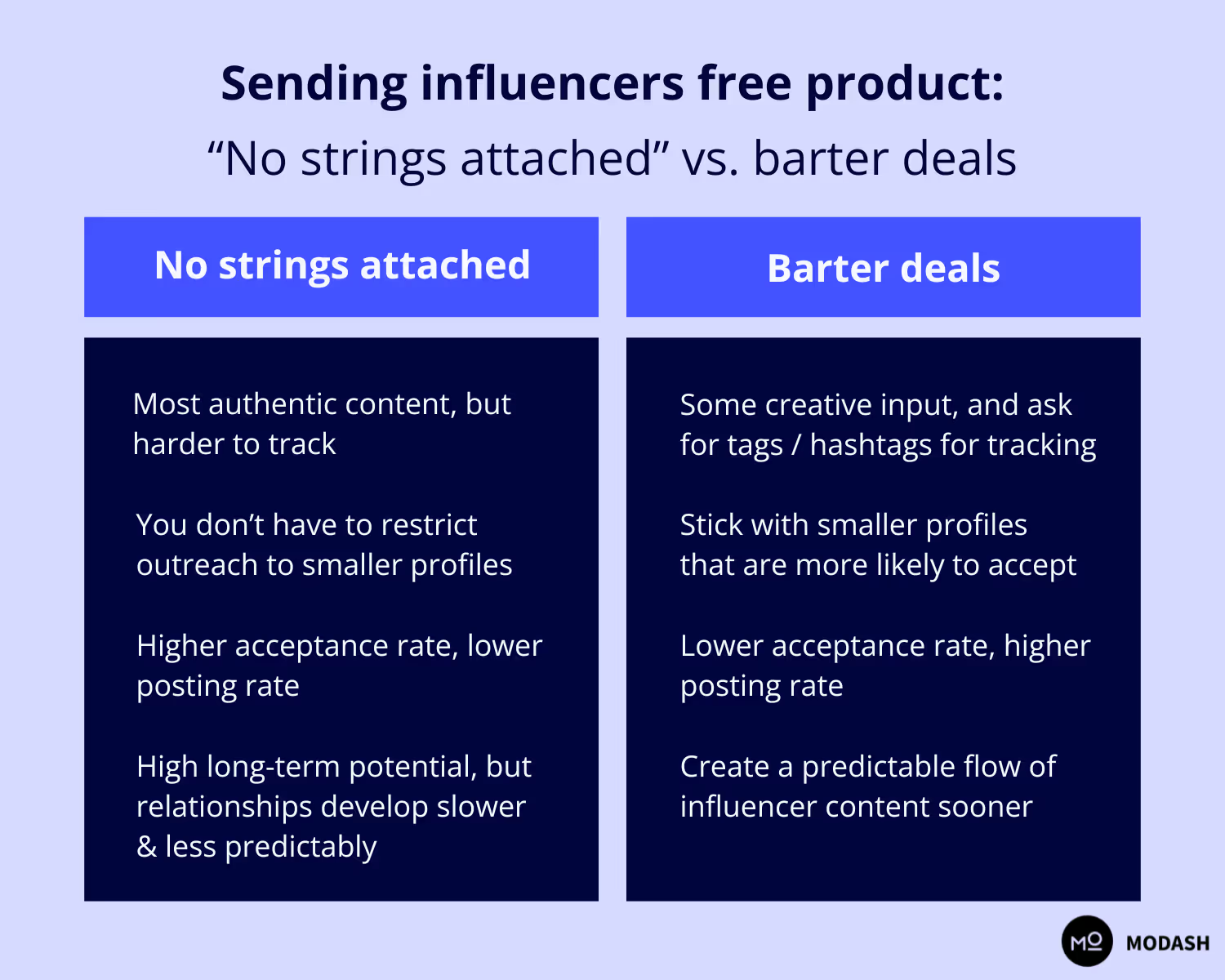
Just 22.6% of influencer marketers run no-strings gifting campaigns all the time, while 54.8% prioritize barter deals.

Why brands choose gifting
Brands choose gifting when they have a limited marketing budget, as it only requires a minimal investment, i.e., cost of goods plus postage and shipping fees.
When we surveyed pro marketers about how to manage influencer gifting programs, we discovered that the most common goal of gifting campaigns is to build brand awareness:

Once an influencer posts about their product, brands can invite them into a revenue-sharing partnership because it tells them that the influencer definitely likes their product and that they’re motivated to share about it with their audience.
Gifting is also a great way for influencers to get free stuff, frankly – and get firsthand experience using a product which can lead to authentic promotions down the line.
🤓Pro tip: When an influencer spontaneously posts as part of a gifting campaign, repurpose their post for your Meta ads. It’s a smart way to test your ads and see which ones convert better!
When to use this payment method
Gifting makes sense as a payment option in the following scenarios:
- Testing the waters. With gifting, you can test the market response to a product before committing to larger campaigns. Gifting is also a low-budget, low-risk way to try out different marketing channels and find which one suits your brand best.
- On a low budget. If you’re starting out and you don’t have cash or systems in place to hire influencers and track campaigns, giving away your product is relatively inexpensive and straightforward. Plus, if both sides are happy with the outcome, a long-term partnership could be in the cards.
- Engaging new or smaller influencers. Getting free gifts is attractive to influencers who are building their accounts or who have smaller followings. It helps them build their reputation and often gives them their first experience working with a brand.
- Nurturing existing partnerships. For example, we often see brands use gifting to keep long-term relationships with ambassadors active.
There’s a caveat, however: don’t try to get a prominent creator’s attention by sending PR or gifts if you have a small budget. Why? These creators are inundated with gifts, and the chances of them seeing and posting about yours are therefore very low.
What to do if influencers don’t respond to your gift
Fact is, gifting campaigns aren’t a hit with all influencers.
So it’s no surprise that expert marketers say the biggest challenges with influencer gifting are:
👉 “It’s hard to get outreach replies for gifted collaborations.”
👉 “I don’t know if the influencer is open to gifting until I reach out.”
👉 “There aren’t enough influencers open to gifted collaborations.”
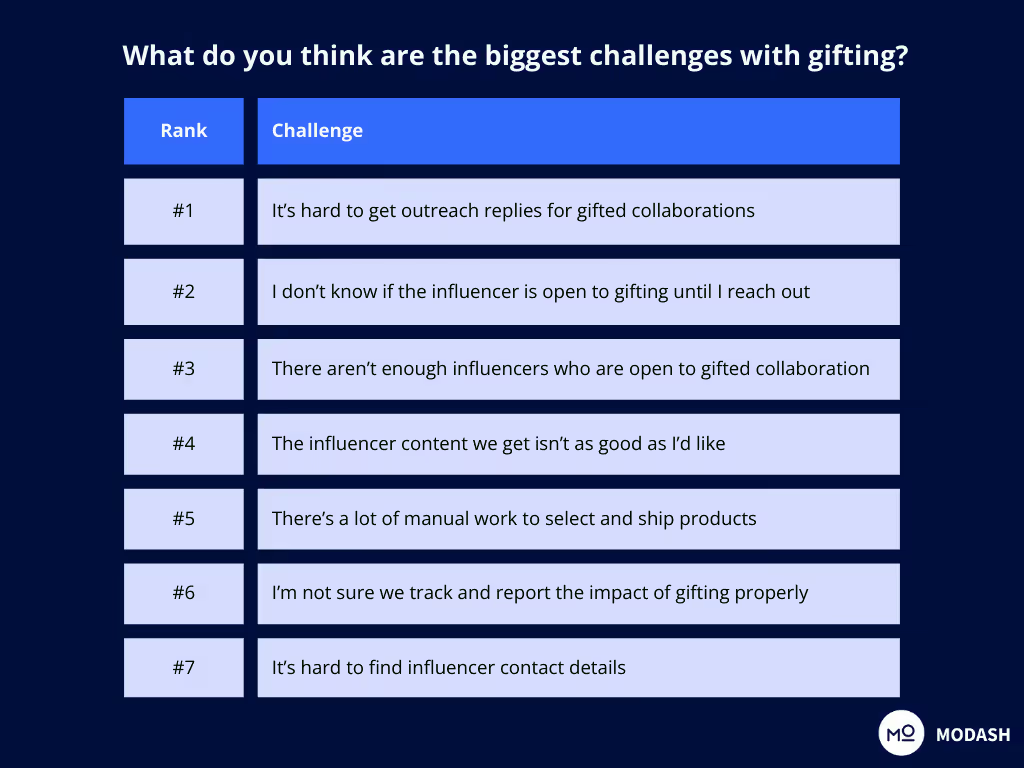
Unfortunately, if you haven’t heard a peep in your inbox after sending a gift and the influencer hasn’t promoted your product online, there’s not much you can do after the fact.
Gifting tends to be a low-commitment option. Without a formal agreement between the influencer and the brand, the influencer may not promote the product at the right time (or at all). Some brands “spray and pray,” mass-sending their free product to lots of influencers and hoping they’ll promote. This approach isn’t strategic or sustainable, so there are no guarantees.
For best results, make sure the product you offer has real value and appeals to the influencer – don’t expect an influencer to get excited about promoting, say, a toothbrush. You can also incentivize influencers to post by offering a discount code (for friends and family, or for their audience) or by offering a second gift if they promote.
5. Comped events or travel
Comped events and travel are mainly used as payment by travel and hospitality brands, offering a free trip or stay in exchange for promotion. More recently, it has fallen out of favor in other industries like beauty and fashion.
Events offer influencers unique experiences as compensation and can work very well for some brands.
Influencers can offer premium content to their followers, while the unique photos and videos of the experience give authenticity to the destination and make for more engaging content.
Why brands choose comped events or travel
Comped events and experiences are like influencer gifting but for travel and hospitality brands. Creators won’t often ask for payment on top of a trip, especially if you’re offering a high-end holiday package.
Brands in lifestyle and luxury niches offer experiences to influencers because they translate into compelling content for their audience.
In a roundtable discussion about influencer payments, pro influencer marketer Ben Williams, formerly at luxury digital marketplace FARFETCH, told us that influencers put out an unusually high volume of content during events. Brands choose to host events or offer trips because they’re likely to get more deliverables for the amount they spend.
For example, if you buy from an influencer’s rate card for $5K, you’ll get less content than if they post about a trip or event that cost you $5K.
🤓Pro tip: A higher volume of content during events doesn’t have to keep you chained to your phone, taking screenshots to keep track. In Modash, you can activate Event Mode which automatically collects all content your chosen influencers post in a given period – you don’t have to worry about catching it all manually!
When to use this payment method
If your brand is in travel or hospitality, paid or partially-paid trips are a no-brainer.
For example, the marketing team at Tourlane sends their partners on week-long, all-expenses-paid trips to a destination of their choice. In exchange, partners post content in three phases:
🛫 Before the trip
🏝️ During the trip
🛬 After the trip
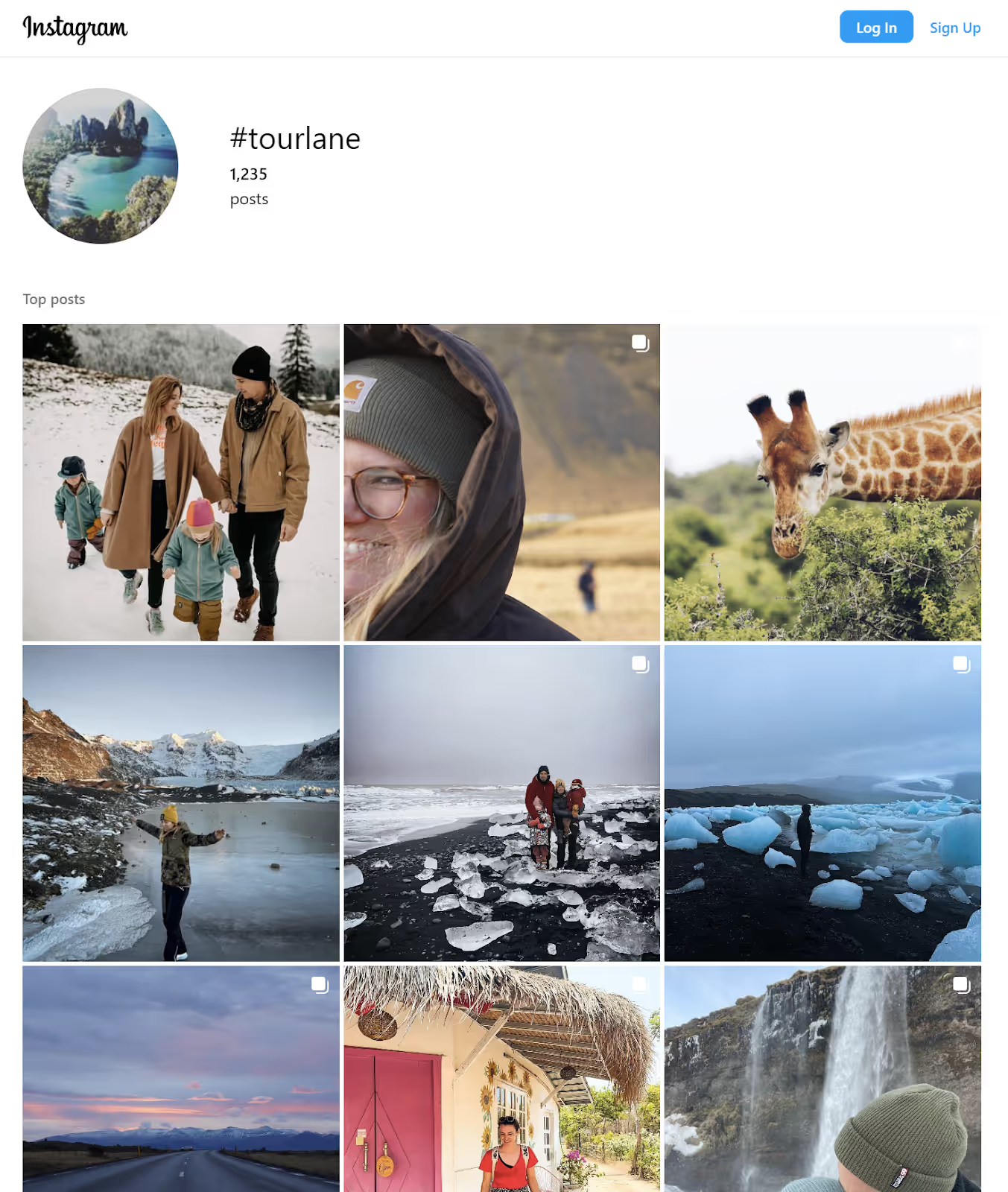
Georgia Humphries, the brand’s influencer marketing team lead, explained the reasoning behind this approach:
The results speak for themselves: influencer marketing at Tourlane drives 5% – 10% of bookings per month (worth hundreds of thousands of euros).
If your brand is in the high-end lifestyle space, exclusive events are a cost-effective way to get tons of unique content from your partners. Events create buzz on social media, so it’s a good idea to use them around special seasons or product launches.
If you’re not in those spaces, you can still use events or travel to keep your ambassadors active.
For example, Deeper Sonars, a brand that offers portable sonars for anglers to 50+ markets globally, puts on a fishing tournament every summer for their ambassadors. It’s a great way to nurture relationships and offer a chance for their partners to create a slew of content about their brand.
What to do if influencers push back
Not all influencers will jump at the chance to attend an event or accept a free travel experience.
If the event doesn’t allow for creative freedom or the travel itinerary is too rigid, influencers might feel that they will have to work harder to make their content extra engaging.
Another reason creators may be wary of events is that the expectations around creating content aren’t clear, or they seem too demanding. For some influencers, the amount of effort it would take to deliver might not be equivalent in value to more direct forms of payment.
To ensure you get the influencer you want to commit to an event or travel opportunity, be flexible about when and how much they should post. (Perhaps ask them to post after the trip, not during it.) Ensure that their personal and audience interests align with your brand and that you have clearly defined content expectations.
Bonus: What about usage rights?
Paying for usage rights is exactly what it sounds like – you’re buying the rights to use an influencer’s content outside of your campaign, such as:
👉 On your website
👉 On your social media channels
👉 In other marketing assets
Once upon a time, you could do this for free. But influencers are becoming increasingly savvy, and many are now aware that they can charge an extra fee for usage rights.
Interestingly, when we surveyed pro influencer marketers for our article on Instagram influencer pricing insights, they said usage rights are the most valuable influencer marketing “add-on.”
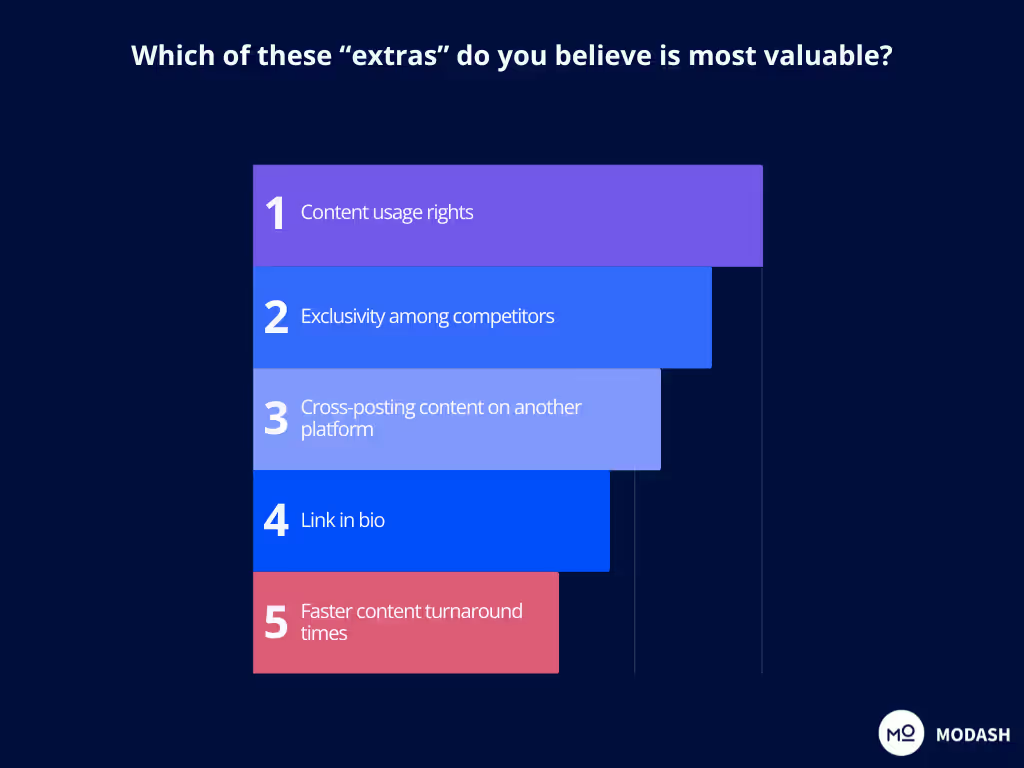
At this point, you might be thinking: why don’t I just ask every influencer for usage rights?
Sure, on one hand, that’d be kinda convenient. If your colleagues in paid social suddenly decide they need influencer content for their Instagram ads, you’ll already have the agreement ready to go. Clever you!
However, in reality, you need to have these conversations with your team up front. Otherwise you’ll get stuck paying for a bunch of content you can’t actually use (and some usage rights agreements aren’t cheap).
Marit Tiesema explains with an example:
Get into the habit of speaking to your adjacent marketing teams about usage rights as part of your standard influencer briefing process.
That way, you’ll be able to identify potential use cases up front, which can help inform your usage rights negotiations. If your social team desperately needs some new ad content, you might be prepared to pay more for usage – whereas if it’s just a “nice to have,” you might have more negotiating power.
🤓 Further reading: Influencer Content Usage Rights: Here’s Everything You Need to Know
How to pay out influencers: Tracking and scaling influencer payments
TL;DR
The way you track payments and pay out influencers will vary depending on a number of factors. But in general, you’ll most likely move through three phases as you scale up and recruit more creator partners:
- Phase 1: Start manually with a spreadsheet.
- Phase 2: Use affiliate software to calculate, track, and pay out performance commissions.
- Phase 3: Use a payment platform like Modash Transactions to handle invoices and payments in high number, particularly for multi-country campaigns, without performance-based pay.
Manually tracking influencer payments and paying creators
To start with, you’ll want to record how much you’re spending per influencer per campaign. You can use a spreadsheet or a tool like Modash to do this.
The benefit of using Modash’s campaign tool is that you get an overview of performance per influencer. Then you can quickly compare which partnerships are generating the most engagements.
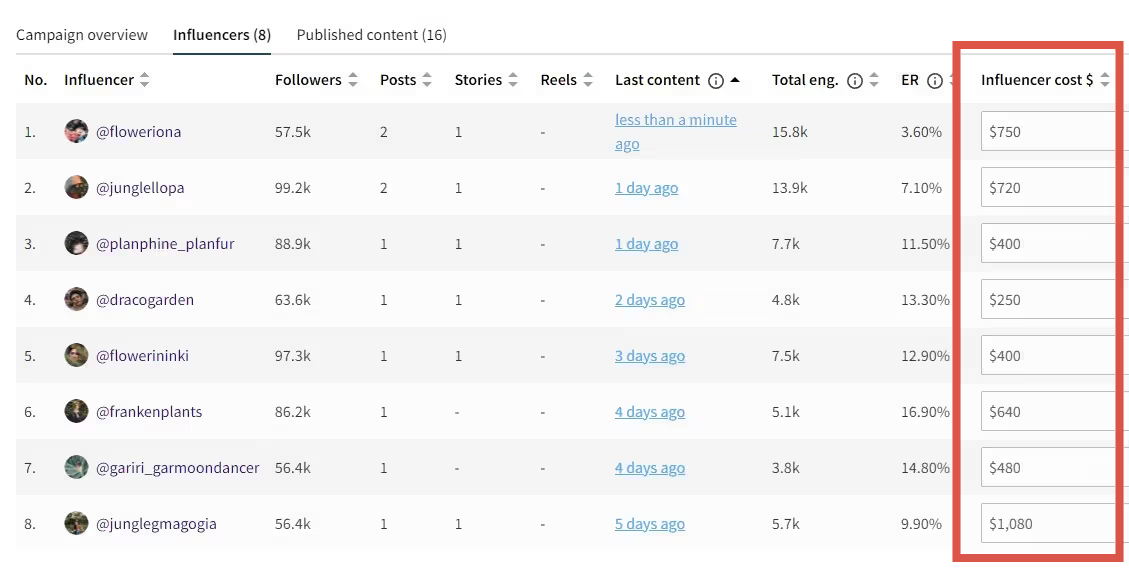
Campaign monitoring also collects content for you automatically. Every Post, Story, Video, or Reel is automatically saved according to the hashtags or mentions you choose to track.
If you’re running an event or have influencers on paid trips, Modash also offers Event Mode. In Event Mode, you select influencers, and we collect all of their content for a given period, regardless of hashtags or mentions. It’s a brilliant way to encourage influencers to simply document and not worry about adding the right hashtags.
Manual tracking is a good option if you’re working with fixed costs (i.e., gifting or pay-per-post) and influencers in your country.
Your workflow will look like this:
- Ask the creator to send you an invoice.
- Check that the amount and company info are accurate.
- Send it to your manager (or finance team) to process and initiate payment.
But once you start scaling your partnerships, or if you’re expanding to international markets, the simple workflow quickly becomes complicated and unmanageable by humans. (We only have two hands!)
That’s when a spreadsheet won’t be enough, and tools can save you.
Using payment tools to track and pay out creators
Payment tools, like affiliate management tools or influencer payment platforms, are designed to take much of the hassle out of the payment process.
For example, when you’re working with international partners or creators who are new to influencing, and you’re doing it at scale, the amount of time you’ll need to spend on payments rises substantially.
Some marketers also become responsible for figuring out the tax rules for different countries, and find themselves looking up the local laws of working with creators.
When you reach that phase, or if you’re currently in it, you may want to consider a tool.
Modash Transactions makes the whole process hands-off. It’s a great option if you’re running non-affiliate campaigns.
All you do is create a Transaction by filling out some details about the influencer and your agreed payment. Then you send a personalized link to the influencer. At this point, Modash takes over and does the rest, including creator onboarding, invoice management, and actual payment. No more worrying about where you are in each partner’s payment workflow!
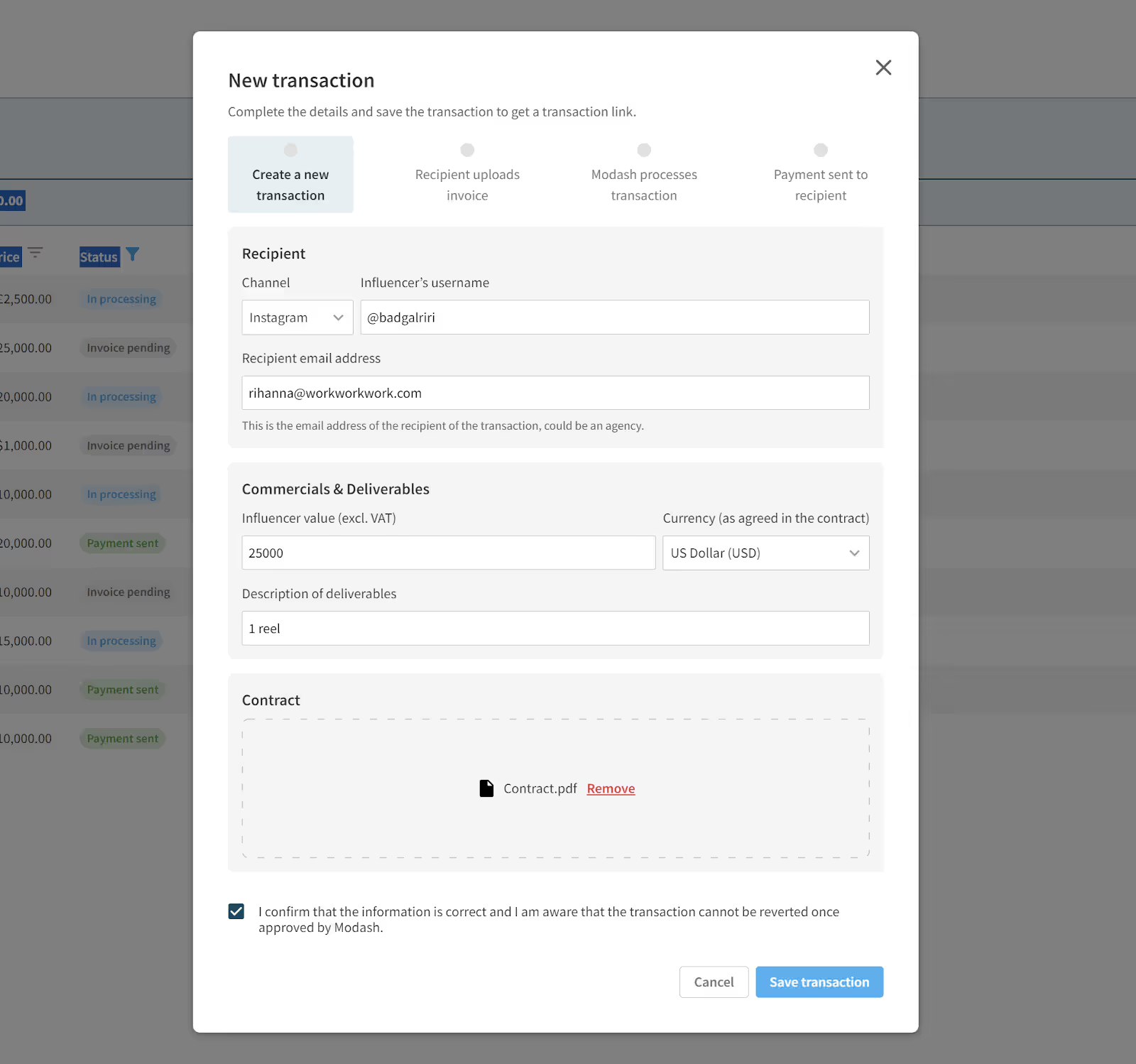
Pay fairly, spend efficiently
Choosing between influencer payment methods comes down to your marketing goals and, of course, your budget. Think about your margins, customer value, and what kind of returns are needed to make this channel profitable. If you have any other marketing channels (e.g., PPC), take a look at what kind of cost-per-acquisition you’re getting there too for a benchmark.
Test out different partnership models, and see what works for you. You can also mix and match payment options, or start with one and change it later in your relationship.
Be creative and always strive for a win-win deal.
Don’t be deterred if a creator says no to you or if a few creators quote you extortionate prices. There’s 250M+ creators in Modash’s influencer discovery platform – the right partners are out there for you. Keep searching, reaching out, and negotiating.


